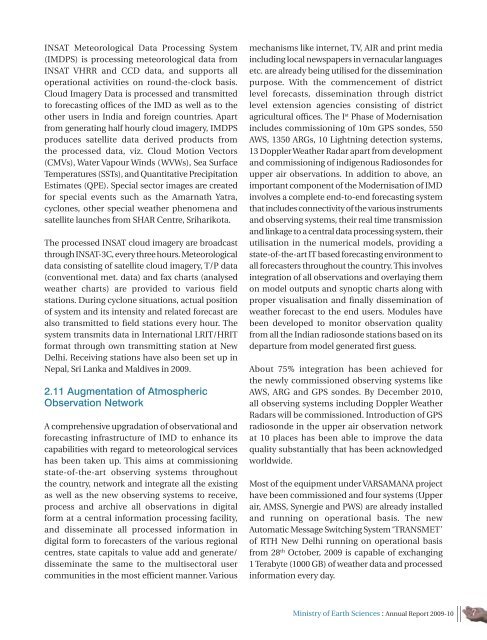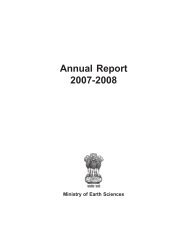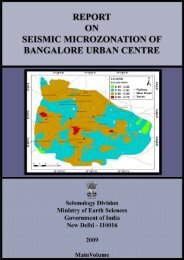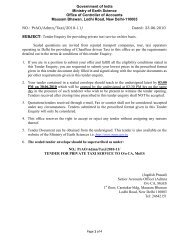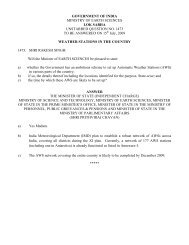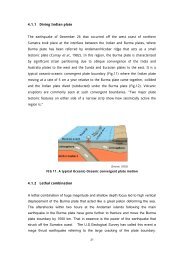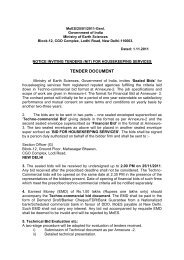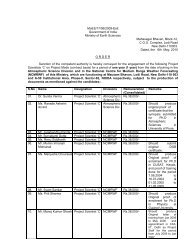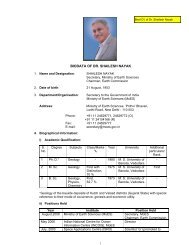Annual Report 2009-2010 - Ministry Of Earth Sciences
Annual Report 2009-2010 - Ministry Of Earth Sciences
Annual Report 2009-2010 - Ministry Of Earth Sciences
You also want an ePaper? Increase the reach of your titles
YUMPU automatically turns print PDFs into web optimized ePapers that Google loves.
INSAT Meteorological Data Processing System<br />
(IMDPS) is processing meteorological data from<br />
INSAT VHRR and CCD data, and supports all<br />
operational activities on round-the-clock basis.<br />
Cloud Imagery Data is processed and transmitted<br />
to forecasting offices of the IMD as well as to the<br />
other users in India and foreign countries. Apart<br />
from generating half hourly cloud imagery, IMDPS<br />
produces satellite data derived products from<br />
the processed data, viz. Cloud Motion Vectors<br />
(CMVs), Water Vapour Winds (WVWs), Sea Surface<br />
Temperatures (SSTs), and Quantitative Precipitation<br />
Estimates (QPE). Special sector images are created<br />
for special events such as the Amarnath Yatra,<br />
cyclones, other special weather phenomena and<br />
satellite launches from SHAR Centre, Sriharikota.<br />
The processed INSAT cloud imagery are broadcast<br />
through INSAT-3C, every three hours. Meteorological<br />
data consisting of satellite cloud imagery, T/P data<br />
(conventional met. data) and fax charts (analysed<br />
weather charts) are provided to various field<br />
stations. During cyclone situations, actual position<br />
of system and its intensity and related forecast are<br />
also transmitted to field stations every hour. The<br />
system transmits data in International LRIT/HRIT<br />
format through own transmitting station at New<br />
Delhi. Receiving stations have also been set up in<br />
Nepal, Sri Lanka and Maldives in <strong>2009</strong>.<br />
2.11 Augmentation of Atmospheric<br />
Observation Network<br />
A comprehensive upgradation of observational and<br />
forecasting infrastructure of IMD to enhance its<br />
capabilities with regard to meteorological services<br />
has been taken up. This aims at commissioning<br />
state-of-the-art observing systems throughout<br />
the country, network and integrate all the existing<br />
as well as the new observing systems to receive,<br />
process and archive all observations in digital<br />
form at a central information processing facility,<br />
and disseminate all processed information in<br />
digital form to forecasters of the various regional<br />
centres, state capitals to value add and generate/<br />
disseminate the same to the multisectoral user<br />
communities in the most efficient manner. Various<br />
mechanisms like internet, TV, AIR and print media<br />
including local newspapers in vernacular languages<br />
etc. are already being utilised for the dissemination<br />
purpose. With the commencement of district<br />
level forecasts, dissemination through district<br />
level extension agencies consisting of district<br />
agricultural offices. The I st Phase of Modernisation<br />
includes commissioning of 10m GPS sondes, 550<br />
AWS, 1350 ARGs, 10 Lightning detection systems,<br />
13 Doppler Weather Radar apart from development<br />
and commissioning of indigenous Radiosondes for<br />
upper air observations. In addition to above, an<br />
important component of the Modernisation of IMD<br />
involves a complete end-to-end forecasting system<br />
that includes connectivity of the various instruments<br />
and observing systems, their real time transmission<br />
and linkage to a central data processing system, their<br />
utilisation in the numerical models, providing a<br />
state-of-the-art IT based forecasting environment to<br />
all forecasters throughout the country. This involves<br />
integration of all observations and overlaying them<br />
on model outputs and synoptic charts along with<br />
proper visualisation and finally dissemination of<br />
weather forecast to the end users. Modules have<br />
been developed to monitor observation quality<br />
from all the Indian radiosonde stations based on its<br />
departure from model generated first guess.<br />
About 75% integration has been achieved for<br />
the newly commissioned observing systems like<br />
AWS, ARG and GPS sondes. By December <strong>2010</strong>,<br />
all observing systems including Doppler Weather<br />
Radars will be commissioned. Introduction of GPS<br />
radiosonde in the upper air observation network<br />
at 10 places has been able to improve the data<br />
quality substantially that has been acknowledged<br />
worldwide.<br />
Most of the equipment under VARSAMANA project<br />
have been commissioned and four systems (Upper<br />
air, AMSS, Synergie and PWS) are already installed<br />
and running on operational basis. The new<br />
Automatic Message Switching System ‘TRANSMET’<br />
of RTH New Delhi running on operational basis<br />
from 28 th October, <strong>2009</strong> is capable of exchanging<br />
1 Terabyte (1000 GB) of weather data and processed<br />
information every day.<br />
<strong>Ministry</strong> of <strong>Earth</strong> <strong>Sciences</strong> : <strong>Annual</strong> <strong>Report</strong> <strong>2009</strong>-10<br />
7


